[English] 日本語
 Yorodumi
Yorodumi- PDB-6wds: Enterovirus D68 in complex with human monoclonal antibody EV68-159 -
+ Open data
Open data
- Basic information
Basic information
| Entry | Database: PDB / ID: 6wds | |||||||||||||||
|---|---|---|---|---|---|---|---|---|---|---|---|---|---|---|---|---|
| Title | Enterovirus D68 in complex with human monoclonal antibody EV68-159 | |||||||||||||||
 Components Components |
| |||||||||||||||
 Keywords Keywords | VIRUS/IMMUNE SYSTEM / virus / enterovirus / antibody / Structural Genomics / Center for Structural Genomics of Infectious Diseases / CSGID / VIRUS-IMMUNE SYSTEM complex | |||||||||||||||
| Function / homology |  Function and homology information Function and homology informationhost cell membrane / cysteine-type peptidase activity / picornain 2A / symbiont-mediated suppression of host mRNA export from nucleus / symbiont genome entry into host cell via pore formation in plasma membrane / picornain 3C / T=pseudo3 icosahedral viral capsid / helicase activity / ribonucleoside triphosphate phosphatase activity / host cell cytoplasmic vesicle membrane ...host cell membrane / cysteine-type peptidase activity / picornain 2A / symbiont-mediated suppression of host mRNA export from nucleus / symbiont genome entry into host cell via pore formation in plasma membrane / picornain 3C / T=pseudo3 icosahedral viral capsid / helicase activity / ribonucleoside triphosphate phosphatase activity / host cell cytoplasmic vesicle membrane / viral capsid / nucleoside-triphosphate phosphatase / host cell / channel activity / monoatomic ion transmembrane transport / host cell cytoplasm / RNA helicase activity / symbiont-mediated suppression of host innate immune response / endocytosis involved in viral entry into host cell / symbiont-mediated suppression of host gene expression / symbiont-mediated activation of host autophagy / RNA-directed RNA polymerase / cysteine-type endopeptidase activity / viral RNA genome replication / RNA-directed RNA polymerase activity / DNA-templated transcription / symbiont entry into host cell / virion attachment to host cell / host cell nucleus / structural molecule activity / proteolysis / RNA binding / zinc ion binding / ATP binding / membrane Similarity search - Function | |||||||||||||||
| Biological species |  Homo sapiens (human) Homo sapiens (human) Enterovirus D68 Enterovirus D68 | |||||||||||||||
| Method | ELECTRON MICROSCOPY / single particle reconstruction / cryo EM / Resolution: 2.9 Å | |||||||||||||||
 Authors Authors | Fu, J. / Klose, T. / Vogt, M.R. / Crowe, J.E. / Rossmann, M.G. / Kuhn, R.J. / Center for Structural Genomics of Infectious Diseases (CSGID) | |||||||||||||||
| Funding support |  United States, 4items United States, 4items
| |||||||||||||||
 Citation Citation |  Journal: Sci Immunol / Year: 2020 Journal: Sci Immunol / Year: 2020Title: Human antibodies neutralize enterovirus D68 and protect against infection and paralytic disease. Authors: Matthew R Vogt / Jianing Fu / Nurgun Kose / Lauren E Williamson / Robin Bombardi / Ian Setliff / Ivelin S Georgiev / Thomas Klose / Michael G Rossmann / Yury A Bochkov / James E Gern / ...Authors: Matthew R Vogt / Jianing Fu / Nurgun Kose / Lauren E Williamson / Robin Bombardi / Ian Setliff / Ivelin S Georgiev / Thomas Klose / Michael G Rossmann / Yury A Bochkov / James E Gern / Richard J Kuhn / James E Crowe /  Abstract: Enterovirus D68 (EV-D68) causes outbreaks of respiratory illness, and there is increasing evidence that it causes outbreaks of acute flaccid myelitis (AFM). There are no licensed therapies to prevent ...Enterovirus D68 (EV-D68) causes outbreaks of respiratory illness, and there is increasing evidence that it causes outbreaks of acute flaccid myelitis (AFM). There are no licensed therapies to prevent or treat EV-D68 infection or AFM disease. We isolated a panel of EV-D68-reactive human monoclonal antibodies that recognize diverse antigenic variants from participants with prior infection. One potently neutralizing cross-reactive antibody, EV68-228, protected mice from respiratory and neurologic disease when given either before or after infection. Cryo-electron microscopy studies revealed that EV68-228 and another potently neutralizing antibody (EV68-159) bound around the fivefold or threefold axes of symmetry on virion particles, respectively. The structures suggest diverse mechanisms of action by these antibodies. The high potency and effectiveness observed in vivo suggest that antibodies are a mechanistic correlate of protection against AFM disease and are candidates for clinical use in humans with EV-D68 infection. | |||||||||||||||
| History |
|
- Structure visualization
Structure visualization
| Movie |
 Movie viewer Movie viewer |
|---|---|
| Structure viewer | Molecule:  Molmil Molmil Jmol/JSmol Jmol/JSmol |
- Downloads & links
Downloads & links
- Download
Download
| PDBx/mmCIF format |  6wds.cif.gz 6wds.cif.gz | 192.2 KB | Display |  PDBx/mmCIF format PDBx/mmCIF format |
|---|---|---|---|---|
| PDB format |  pdb6wds.ent.gz pdb6wds.ent.gz | 150.2 KB | Display |  PDB format PDB format |
| PDBx/mmJSON format |  6wds.json.gz 6wds.json.gz | Tree view |  PDBx/mmJSON format PDBx/mmJSON format | |
| Others |  Other downloads Other downloads |
-Validation report
| Summary document |  6wds_validation.pdf.gz 6wds_validation.pdf.gz | 914 KB | Display |  wwPDB validaton report wwPDB validaton report |
|---|---|---|---|---|
| Full document |  6wds_full_validation.pdf.gz 6wds_full_validation.pdf.gz | 927.8 KB | Display | |
| Data in XML |  6wds_validation.xml.gz 6wds_validation.xml.gz | 47.9 KB | Display | |
| Data in CIF |  6wds_validation.cif.gz 6wds_validation.cif.gz | 72.2 KB | Display | |
| Arichive directory |  https://data.pdbj.org/pub/pdb/validation_reports/wd/6wds https://data.pdbj.org/pub/pdb/validation_reports/wd/6wds ftp://data.pdbj.org/pub/pdb/validation_reports/wd/6wds ftp://data.pdbj.org/pub/pdb/validation_reports/wd/6wds | HTTPS FTP |
-Related structure data
| Related structure data |  21647MC  6wdtC M: map data used to model this data C: citing same article ( |
|---|---|
| Similar structure data |
- Links
Links
- Assembly
Assembly
| Deposited unit | 
|
|---|---|
| 1 | x 60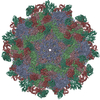
|
| 2 |
|
| 3 | x 5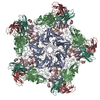
|
| 4 | x 6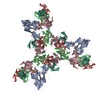
|
| 5 | 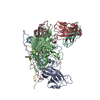
|
| Symmetry | Point symmetry: (Schoenflies symbol: I (icosahedral)) |
- Components
Components
-Viral protein ... , 4 types, 4 molecules ABCD
| #2: Protein | Mass: 32920.309 Da / Num. of mol.: 1 / Fragment: UNP residues 565-861 Source method: isolated from a genetically manipulated source Source: (gene. exp.)  Enterovirus D68 / Strain: US/MO/14-18047 / Cell (production host): spindle / Cell line (production host): RD / Production host: Enterovirus D68 / Strain: US/MO/14-18047 / Cell (production host): spindle / Cell line (production host): RD / Production host:  Homo sapiens (human) / Tissue (production host): muscle / References: UniProt: A0A097BW12 Homo sapiens (human) / Tissue (production host): muscle / References: UniProt: A0A097BW12 |
|---|---|
| #3: Protein | Mass: 27567.135 Da / Num. of mol.: 1 / Fragment: UNP residues 70-317 Source method: isolated from a genetically manipulated source Source: (gene. exp.)  Enterovirus D68 / Strain: US/MO/14-18047 / Cell (production host): spindle / Cell line (production host): RD / Production host: Enterovirus D68 / Strain: US/MO/14-18047 / Cell (production host): spindle / Cell line (production host): RD / Production host:  Homo sapiens (human) / Tissue (production host): muscle / References: UniProt: A0A0A7X639, UniProt: A0A097BW12*PLUS Homo sapiens (human) / Tissue (production host): muscle / References: UniProt: A0A0A7X639, UniProt: A0A097BW12*PLUS |
| #4: Protein | Mass: 27112.814 Da / Num. of mol.: 1 / Fragment: UNP residues 318-564 Source method: isolated from a genetically manipulated source Source: (gene. exp.)  Enterovirus D68 / Strain: US/MO/14-18047 / Cell (production host): spindle / Cell line (production host): RD / Production host: Enterovirus D68 / Strain: US/MO/14-18047 / Cell (production host): spindle / Cell line (production host): RD / Production host:  Homo sapiens (human) / Tissue (production host): muscle / References: UniProt: A0A097BW12 Homo sapiens (human) / Tissue (production host): muscle / References: UniProt: A0A097BW12 |
| #5: Protein | Mass: 7336.960 Da / Num. of mol.: 1 / Fragment: UNP residues 2-69 Source method: isolated from a genetically manipulated source Source: (gene. exp.)  Enterovirus D68 / Strain: US/MO/14-18047 / Cell (production host): spindle / Cell line (production host): RD / Production host: Enterovirus D68 / Strain: US/MO/14-18047 / Cell (production host): spindle / Cell line (production host): RD / Production host:  Homo sapiens (human) / Tissue (production host): muscle / References: UniProt: A0A126D252, UniProt: J9Z449*PLUS Homo sapiens (human) / Tissue (production host): muscle / References: UniProt: A0A126D252, UniProt: J9Z449*PLUS |
-Antibody , 2 types, 2 molecules LH
| #1: Antibody | Mass: 11715.928 Da / Num. of mol.: 1 Source method: isolated from a genetically manipulated source Source: (gene. exp.)  Homo sapiens (human) / Production host: Homo sapiens (human) / Production host:  |
|---|---|
| #6: Antibody | Mass: 13003.529 Da / Num. of mol.: 1 Source method: isolated from a genetically manipulated source Source: (gene. exp.)  Homo sapiens (human) / Production host: Homo sapiens (human) / Production host:  |
-Details
| Has protein modification | Y |
|---|
-Experimental details
-Experiment
| Experiment | Method: ELECTRON MICROSCOPY |
|---|---|
| EM experiment | Aggregation state: PARTICLE / 3D reconstruction method: single particle reconstruction |
- Sample preparation
Sample preparation
| Component |
| ||||||||||||||||||||||||
|---|---|---|---|---|---|---|---|---|---|---|---|---|---|---|---|---|---|---|---|---|---|---|---|---|---|
| Molecular weight | Experimental value: NO | ||||||||||||||||||||||||
| Source (natural) |
| ||||||||||||||||||||||||
| Source (recombinant) |
| ||||||||||||||||||||||||
| Details of virus | Empty: NO / Enveloped: NO / Isolate: STRAIN / Type: VIRION | ||||||||||||||||||||||||
| Buffer solution | pH: 8 | ||||||||||||||||||||||||
| Specimen | Embedding applied: NO / Shadowing applied: NO / Staining applied: NO / Vitrification applied: YES | ||||||||||||||||||||||||
| Specimen support | Grid material: COPPER / Grid mesh size: 400 divisions/in. | ||||||||||||||||||||||||
| Vitrification | Instrument: GATAN CRYOPLUNGE 3 / Cryogen name: ETHANE |
- Electron microscopy imaging
Electron microscopy imaging
| Experimental equipment |  Model: Titan Krios / Image courtesy: FEI Company |
|---|---|
| Microscopy | Model: FEI TITAN KRIOS |
| Electron gun | Electron source:  FIELD EMISSION GUN / Accelerating voltage: 300 kV / Illumination mode: FLOOD BEAM FIELD EMISSION GUN / Accelerating voltage: 300 kV / Illumination mode: FLOOD BEAM |
| Electron lens | Mode: BRIGHT FIELD / Nominal magnification: 81000 X / Cs: 2.7 mm / C2 aperture diameter: 100 µm / Alignment procedure: ZEMLIN TABLEAU |
| Specimen holder | Cryogen: NITROGEN / Specimen holder model: FEI TITAN KRIOS AUTOGRID HOLDER |
| Image recording | Average exposure time: 12 sec. / Electron dose: 31.4 e/Å2 / Detector mode: SUPER-RESOLUTION / Film or detector model: GATAN K2 SUMMIT (4k x 4k) / Num. of grids imaged: 1 / Num. of real images: 732 |
| EM imaging optics | Energyfilter name: GIF Bioquantum / Energyfilter slit width: 20 eV |
- Processing
Processing
| Software | Name: PHENIX / Version: 1.16_3549: / Classification: refinement | ||||||||||||||||||||||||||||||
|---|---|---|---|---|---|---|---|---|---|---|---|---|---|---|---|---|---|---|---|---|---|---|---|---|---|---|---|---|---|---|---|
| EM software |
| ||||||||||||||||||||||||||||||
| CTF correction | Type: PHASE FLIPPING AND AMPLITUDE CORRECTION | ||||||||||||||||||||||||||||||
| Particle selection | Num. of particles selected: 42078 | ||||||||||||||||||||||||||||||
| Symmetry | Point symmetry: I (icosahedral) | ||||||||||||||||||||||||||||||
| 3D reconstruction | Resolution: 2.9 Å / Resolution method: FSC 0.143 CUT-OFF / Num. of particles: 30554 / Algorithm: FOURIER SPACE / Symmetry type: POINT | ||||||||||||||||||||||||||||||
| Atomic model building | Protocol: RIGID BODY FIT / Space: REAL | ||||||||||||||||||||||||||||||
| Atomic model building | PDB-ID: 4WM8 Accession code: 4WM8 / Source name: PDB / Type: experimental model | ||||||||||||||||||||||||||||||
| Refine LS restraints |
|
 Movie
Movie Controller
Controller



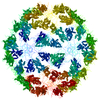
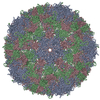
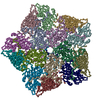
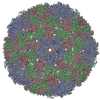
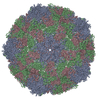
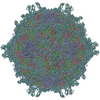
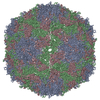
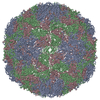
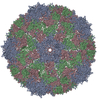

 PDBj
PDBj




